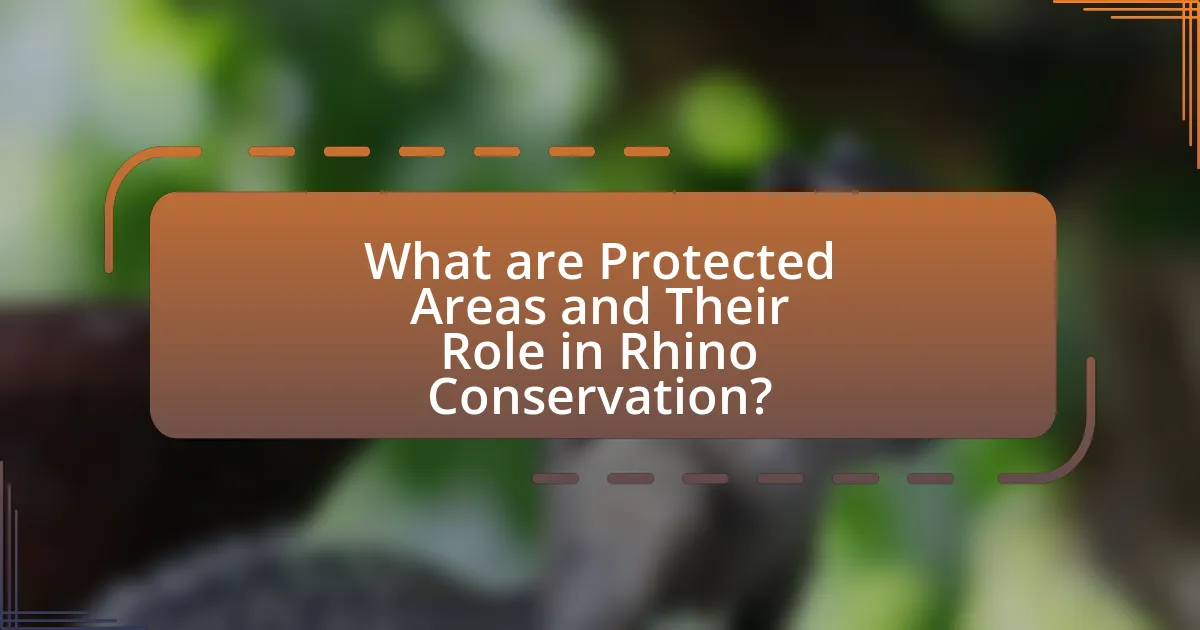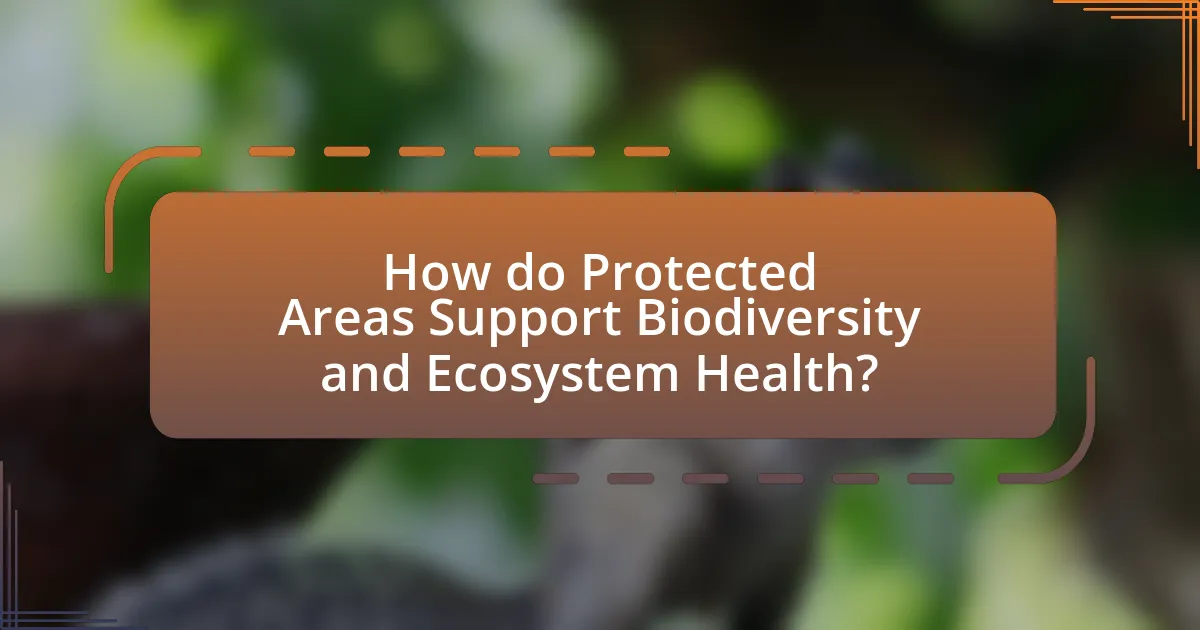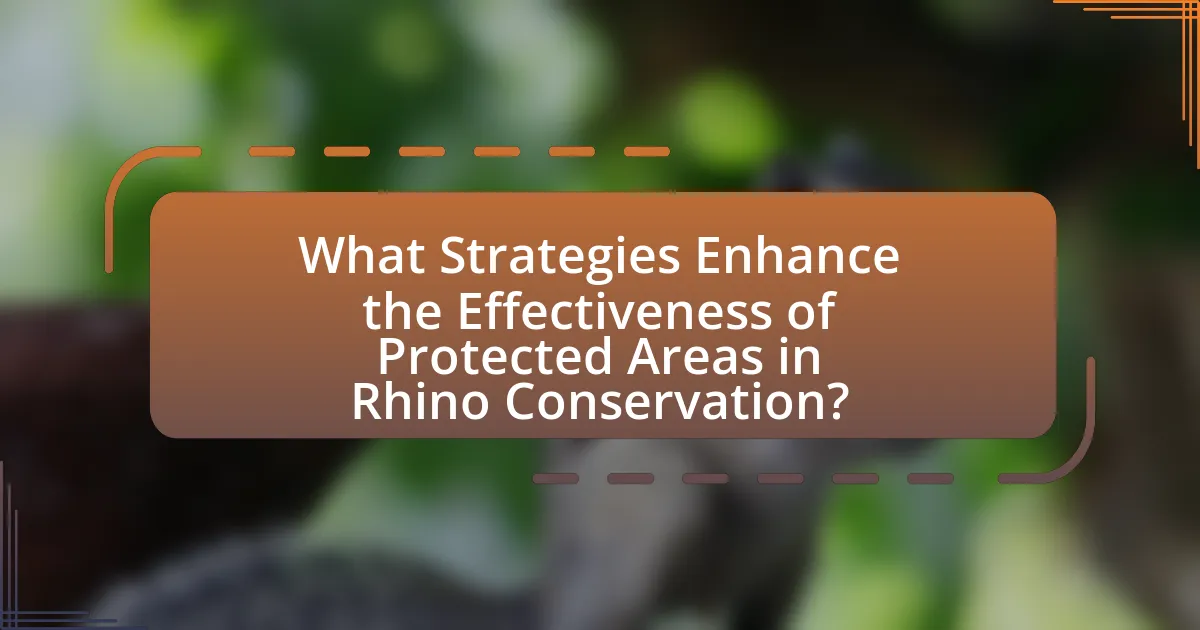Protected areas are designated regions that provide essential habitats for wildlife, particularly rhinos, by limiting human activities that threaten their survival. This article examines the critical role of protected areas in rhino conservation, highlighting their effectiveness in stabilizing and increasing rhino populations through measures such as anti-poaching efforts and habitat management. It also discusses the various types of protected areas, the challenges they face, and the importance of community engagement in conservation strategies. Additionally, the article explores how technology and research within these areas contribute to the ongoing protection and understanding of rhinos, emphasizing the need for effective policies to ensure their long-term survival.

What are Protected Areas and Their Role in Rhino Conservation?
Protected areas are designated regions that provide a safe habitat for wildlife, including rhinos, by restricting human activities that could threaten their survival. These areas play a crucial role in rhino conservation by offering protection from poaching, habitat destruction, and human-wildlife conflict. For instance, according to the International Union for Conservation of Nature (IUCN), protected areas have been instrumental in stabilizing and increasing rhino populations in regions like South Africa, where the establishment of national parks has led to a significant rise in white rhino numbers from fewer than 100 individuals in the 1900s to over 18,000 today. This demonstrates that effective management and enforcement within protected areas are vital for the long-term survival of rhinos.
Why are Protected Areas essential for Rhino populations?
Protected Areas are essential for Rhino populations because they provide a safe habitat that protects these animals from poaching and habitat loss. These designated regions help maintain stable ecosystems, which are crucial for the survival of rhinos by ensuring access to food, water, and breeding grounds. For instance, in South Africa, the establishment of Kruger National Park has been instrumental in increasing the white rhino population from fewer than 100 individuals in the 1900s to over 18,000 today, demonstrating the effectiveness of protected areas in conservation efforts.
What types of Protected Areas exist for Rhino conservation?
Protected Areas for rhino conservation include national parks, wildlife reserves, and sanctuaries. National parks, such as Kruger National Park in South Africa, provide large, protected habitats where rhinos can thrive without human interference. Wildlife reserves, like the Ol Pejeta Conservancy in Kenya, focus on both conservation and community engagement, allowing for sustainable coexistence. Sanctuaries, such as the Rhino Sanctuary in Nepal, specifically cater to the rehabilitation and protection of rhinos, often rescuing individuals from poaching threats. These types of protected areas are crucial for maintaining rhino populations and their habitats, as they offer legal protection and management strategies aimed at reducing poaching and habitat loss.
How do Protected Areas contribute to habitat preservation for Rhinos?
Protected Areas contribute to habitat preservation for Rhinos by providing a secure environment that protects them from poaching and habitat destruction. These designated regions often encompass critical ecosystems that support the rhino’s dietary and reproductive needs, ensuring their survival. For example, in countries like South Africa, protected areas such as Kruger National Park have implemented anti-poaching measures and habitat management strategies, resulting in a significant increase in rhino populations. According to the International Rhino Foundation, protected areas are essential for maintaining biodiversity and ecological balance, which directly benefits rhinos by preserving their natural habitats.
What challenges do Protected Areas face in Rhino conservation?
Protected Areas face significant challenges in Rhino conservation, primarily due to poaching, habitat loss, and insufficient funding. Poaching remains a critical threat, with rhinos targeted for their horns, leading to drastic population declines; for instance, in South Africa, rhino poaching increased from 13 in 2007 to over 1,000 in 2014. Habitat loss, driven by agricultural expansion and urban development, reduces the available space for rhinos to thrive, further endangering their survival. Additionally, many Protected Areas struggle with inadequate financial resources, limiting their ability to implement effective conservation strategies and maintain anti-poaching patrols. These factors collectively undermine the effectiveness of Protected Areas in safeguarding rhino populations.
How does poaching impact Protected Areas and Rhino populations?
Poaching severely impacts Protected Areas and Rhino populations by leading to significant declines in rhino numbers and undermining conservation efforts. In regions where poaching is prevalent, such as South Africa, rhino populations have decreased from approximately 20,000 in 2012 to around 18,000 in 2021, primarily due to illegal hunting for their horns. This decline disrupts the ecological balance within Protected Areas, as rhinos play a crucial role in their habitats by influencing vegetation dynamics and supporting other wildlife species. Furthermore, the threat of poaching can deter tourism and funding for conservation initiatives, further exacerbating the challenges faced by Protected Areas in maintaining biodiversity and ecosystem health.
What are the effects of climate change on Protected Areas for Rhinos?
Climate change negatively impacts Protected Areas for Rhinos by altering their habitats and food availability. Rising temperatures and changing precipitation patterns can lead to habitat degradation, reducing the quality and quantity of vegetation that rhinos rely on for sustenance. Additionally, climate change can increase the frequency and intensity of extreme weather events, such as droughts and floods, which further threaten the stability of these ecosystems. For instance, a study published in the journal “Global Change Biology” indicates that shifts in climate zones could result in the loss of suitable habitats for rhinos, potentially leading to population declines.

How do Protected Areas Support Biodiversity and Ecosystem Health?
Protected areas support biodiversity and ecosystem health by providing habitats that protect various species from threats such as habitat loss, poaching, and climate change. These designated regions serve as refuges where flora and fauna can thrive without human interference, thereby maintaining ecological balance. For instance, a study published in “Nature” by Watson et al. (2014) found that protected areas are crucial for conserving 80% of the world’s terrestrial biodiversity. Additionally, these areas help preserve ecosystem services, such as water purification and carbon sequestration, which are vital for overall environmental health.
What is the relationship between Protected Areas and biodiversity?
Protected Areas play a crucial role in preserving biodiversity by providing safe habitats for various species, including rhinos. These designated regions help maintain ecological balance, protect endangered species, and promote genetic diversity. Research indicates that Protected Areas can significantly reduce species extinction rates; for instance, a study published in “Nature” by J. E. M. Baillie et al. (2015) found that areas with legal protection have a higher likelihood of sustaining biodiversity compared to unprotected regions. This relationship underscores the importance of Protected Areas in conserving not only rhinos but also the broader ecosystems they inhabit.
How do Protected Areas help maintain ecological balance?
Protected Areas help maintain ecological balance by providing a safe habitat for diverse species, including rhinos, which are crucial for ecosystem stability. These areas protect biodiversity by preserving natural habitats, allowing species to thrive without the pressures of habitat destruction and poaching. For instance, the establishment of protected areas has been shown to increase species richness and abundance, as evidenced by studies indicating that protected regions often host 50% more species than unprotected areas. This preservation of biodiversity is essential for ecosystem functions such as pollination, nutrient cycling, and water purification, which are vital for maintaining ecological balance.
What role do Rhinos play in their ecosystems within Protected Areas?
Rhinos play a crucial role in their ecosystems within Protected Areas by acting as ecosystem engineers and influencing vegetation dynamics. Their grazing habits help maintain the structure of grasslands and savannas, promoting biodiversity by allowing various plant species to thrive. For instance, the white rhino’s selective grazing encourages the growth of shorter grasses, which benefits other herbivores and contributes to a balanced ecosystem. Additionally, rhinos facilitate nutrient cycling through their dung, which enriches the soil and supports plant growth. This ecological impact is vital for maintaining the health and stability of their habitats, ultimately supporting a wide range of wildlife.
How do Protected Areas facilitate research and education on Rhinos?
Protected Areas facilitate research and education on Rhinos by providing controlled environments where scientists can study their behavior, genetics, and ecology without human interference. These areas serve as natural laboratories, enabling researchers to gather data on rhino populations, monitor their health, and assess the impacts of conservation strategies. For instance, studies conducted in protected areas have revealed critical insights into rhino social structures and breeding patterns, which are essential for effective management and conservation efforts. Additionally, educational programs within these areas raise awareness about rhino conservation, engaging local communities and fostering a sense of stewardship, which is vital for the long-term survival of rhinos.
What are the benefits of research conducted in Protected Areas for Rhino conservation?
Research conducted in Protected Areas significantly enhances Rhino conservation by providing critical data on population dynamics, habitat use, and threats. This data informs effective management strategies, ensuring that conservation efforts are tailored to the specific needs of Rhino populations. For instance, studies have shown that monitoring Rhino movements within these areas helps identify key habitats and migration corridors, which are essential for their survival. Additionally, research can reveal the impact of poaching and habitat loss, allowing for targeted interventions. Evidence from the International Rhino Foundation indicates that areas with ongoing research initiatives have seen a 30% increase in Rhino populations over the past decade, demonstrating the direct benefits of such research for conservation outcomes.
How can education programs in Protected Areas promote Rhino conservation?
Education programs in Protected Areas can promote Rhino conservation by raising awareness about the ecological importance of rhinos and the threats they face. These programs educate local communities and visitors about rhino behavior, habitat needs, and the impact of poaching, fostering a sense of stewardship. For instance, studies have shown that community-based education initiatives can lead to increased local support for conservation efforts, as seen in South Africa’s Kruger National Park, where educational outreach has resulted in a 30% reduction in poaching incidents over five years. By empowering communities with knowledge, education programs create advocates for rhino protection, ultimately contributing to the species’ survival.

What Strategies Enhance the Effectiveness of Protected Areas in Rhino Conservation?
Effective strategies for enhancing the effectiveness of protected areas in rhino conservation include robust anti-poaching measures, community engagement, habitat restoration, and effective law enforcement. Anti-poaching measures, such as increased ranger patrols and the use of technology like drones and camera traps, have been shown to significantly reduce poaching incidents; for instance, in South Africa, the deployment of advanced surveillance technology has led to a 30% decrease in rhino poaching rates. Community engagement fosters local support for conservation efforts, as seen in Namibia, where community-based conservation programs have empowered local populations and resulted in increased rhino populations. Habitat restoration initiatives, which improve the ecological health of protected areas, are crucial for sustaining rhino populations, as demonstrated by successful rewilding projects in various regions. Lastly, effective law enforcement, supported by strong legal frameworks and international cooperation, is essential for deterring wildlife crime, evidenced by the success of the African Elephant and Rhino Protection Act in reducing illegal trade.
How can community involvement improve Protected Area management?
Community involvement can significantly improve Protected Area management by fostering local stewardship and enhancing conservation efforts. Engaging local communities in decision-making processes leads to increased accountability and a sense of ownership over natural resources. For instance, studies have shown that when communities participate in the management of Protected Areas, poaching rates decrease, as local residents become active protectors of wildlife, including rhinos. A report by the World Wildlife Fund indicates that community-managed areas in Africa have seen a 50% reduction in poaching incidents compared to areas without community involvement. This collaborative approach not only strengthens conservation outcomes but also promotes sustainable livelihoods for local populations, creating a win-win scenario for both biodiversity and community welfare.
What are successful examples of community-led conservation initiatives?
Successful examples of community-led conservation initiatives include the Namibian communal conservancies and the Maasai Mara Wildlife Conservancies in Kenya. In Namibia, communal conservancies have led to a significant increase in wildlife populations, including rhinos, by empowering local communities to manage and benefit from their natural resources. This model has resulted in a 50% increase in the black rhino population from 1995 to 2015, demonstrating the effectiveness of community involvement in conservation efforts. Similarly, the Maasai Mara Wildlife Conservancies have successfully integrated local pastoralist communities into wildlife management, leading to improved habitat protection and increased tourism revenue, which supports both conservation and local livelihoods. These initiatives highlight the critical role that local communities play in the success of conservation strategies.
How does local engagement impact the success of Protected Areas?
Local engagement significantly enhances the success of Protected Areas by fostering community stewardship and support for conservation efforts. When local communities are actively involved in the management and decision-making processes of Protected Areas, they are more likely to prioritize the protection of biodiversity and natural resources. Studies have shown that areas with strong local engagement experience lower rates of poaching and habitat destruction, as communities develop a vested interest in the health of their environment. For instance, a report by the World Wildlife Fund indicated that community-managed reserves in Africa have seen a 50% reduction in poaching incidents compared to those without local involvement. This evidence underscores the critical role that local engagement plays in ensuring the effectiveness and sustainability of Protected Areas in rhino conservation.
What best practices can be implemented in Protected Areas for Rhino conservation?
Effective best practices for Rhino conservation in Protected Areas include implementing anti-poaching measures, enhancing habitat management, and engaging local communities. Anti-poaching measures, such as increased ranger patrols and the use of technology like drones and camera traps, have proven successful in reducing poaching incidents; for instance, in South Africa, the deployment of advanced surveillance has led to a significant decrease in rhino poaching rates. Habitat management involves maintaining and restoring ecosystems to ensure that rhinos have access to sufficient food and water resources, which is critical for their survival. Engaging local communities through education and economic incentives fosters a sense of ownership and responsibility towards conservation efforts, as seen in various community-based conservation programs that have successfully reduced human-wildlife conflict while promoting sustainable livelihoods. These practices collectively contribute to the effective conservation of rhinos within Protected Areas.
How can technology be utilized to monitor and protect Rhinos in Protected Areas?
Technology can be utilized to monitor and protect rhinos in protected areas through the implementation of GPS tracking, drones, and camera traps. GPS tracking devices allow conservationists to monitor rhino movements in real-time, providing data on their behavior and habitat use, which is crucial for effective management. Drones enhance surveillance capabilities by covering large areas quickly, enabling the detection of poachers and monitoring rhino populations from the air. Camera traps serve as an effective tool for capturing images of rhinos and other wildlife, helping to assess population sizes and health. According to a study published in the journal “Conservation Biology,” the use of these technologies has significantly improved anti-poaching efforts and population monitoring, demonstrating their effectiveness in rhino conservation.
What policies are effective in strengthening the protection of Rhinos in these areas?
Effective policies for strengthening the protection of rhinos in protected areas include anti-poaching measures, habitat conservation, and community engagement initiatives. Anti-poaching measures, such as increased patrolling and surveillance, have been shown to reduce poaching incidents significantly; for example, in South Africa, the deployment of specialized anti-poaching units has led to a decrease in rhino poaching rates. Habitat conservation policies that focus on preserving and restoring natural habitats ensure that rhinos have access to sufficient food and water resources, which is critical for their survival. Additionally, community engagement initiatives that involve local populations in conservation efforts foster a sense of ownership and responsibility, leading to increased support for rhino protection. Studies indicate that when local communities benefit from conservation, such as through eco-tourism, they are more likely to protect rhinos and their habitats.
What are the key takeaways for effective Rhino conservation in Protected Areas?
Key takeaways for effective rhino conservation in protected areas include strong anti-poaching measures, habitat management, community engagement, and monitoring of rhino populations. Anti-poaching measures are critical, as poaching remains a leading threat; for instance, in South Africa, rhino poaching decreased by 33% from 2018 to 2019 due to enhanced law enforcement efforts. Habitat management ensures that rhinos have access to sufficient food and water, which is essential for their survival. Engaging local communities fosters support for conservation initiatives, as seen in Namibia, where community-based conservation has led to increased rhino populations. Lastly, regular monitoring of rhino populations helps assess the effectiveness of conservation strategies and adapt them as necessary, ensuring long-term success in protected areas.
